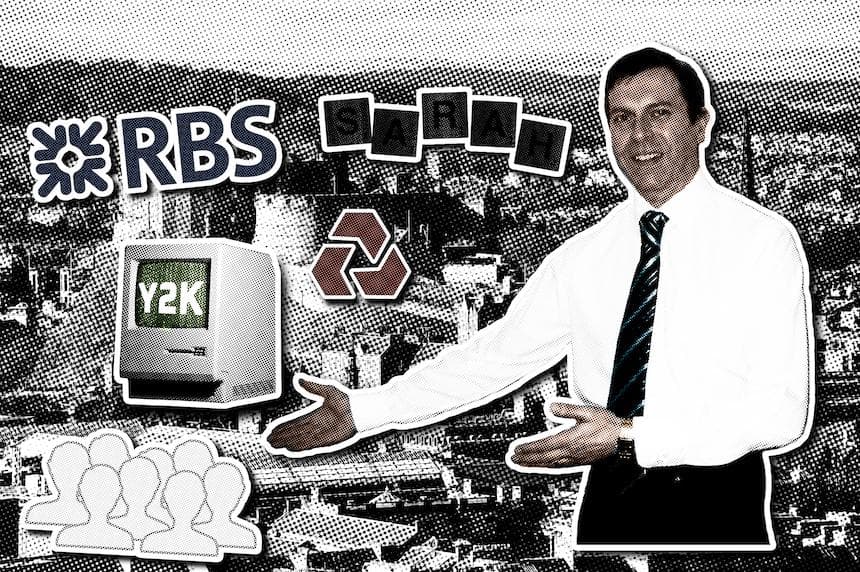A Leadership Journey: The Working Years (Part 2 - NatWest Integration)

It took another couple of years before I started to understand that I was on a leadership journey, and I needed to make more conscious efforts to do something about it. Again, motivation came first. After setting direction on Y2K, I moved from the Ops Y2K PM role into managing the team responsible for 2 systems that underpin all payment transactions in RBS, and which had to be made Y2K compliant before any others. Having succeeded on that, I was pulled onto other roles before finding myself, in November 2000, having to take time off after catching pneumonia. When I came back, the project I had been managing had been moved to London, as had my deputy, so there was no point me picking it up again.
There was a new role that needed filling – Divisional Test Manager (DTM) on NatWest Integration for what was now known as Manufacturing Division. It was a bit like Y2K – our Division was a bit behind the rest, and there was a central plan being driven by consultants which I felt was fundamentally the wrong approach. There were numerous teams initiating countless business projects to capture the requirements of the current NatWest business, and drive the work to amend the RBSG systems to meet those requirements, with an exception process to enable NatWest systems to become part of the new Group portfolio of systems. However, the basic premise of the takeover was that RBSG systems would be scaled up to take on the volume of NatWest customers and data, so all this effort on projects did help people to understand the different operating model, but was not going in the direction that would give the desired result. I explained to my manager, Dave Smailes, that what we needed was something more like a traditional industrial manufacturing process, because what we had to build was more (or bigger versions) of the same systems to get the required scale. That meant we needed three things:
- An inventory of all the systems that made up the RBS estate, designed to be a bit like the Modular Structure I’d seen used by the Manufacturing teams when working at Unisys in Livingston, the idea being we could pick from the Inventory to build the systems required for any brand in any environment (development, test, pre-production and production)
- An approach to integrating, testing and implementing into production the systems, since (simplistically) we just needed the same systems to provide the same functions
- A team structure to coordinate this activity, based around “ownership” of the systems, regardless of which project was running in which department making changes to them
Dave – like Stephen – was from a technical background and was comfortable with the detail. He took the time to understand my proposals, while we both continued doing our jobs on the consultants’ approach to Integration. This included the responsibility for providing large-scale integration test environments, which gave myself and Dave the opportunity to gain agreement for me to start collating what became known as the Application Inventory List, as well as setting up an informal structure based around a similar division of systems from Y2K, with Implementation Stream Managers (ISMs) as the contact points for sets of related Partitions, and Partition Managers for sets of related systems. Linda Webster was my counterpart as DTM for the Retail development area, and was my main supporter in helping to get the structure established. She had her own vision for how the initial testing of systems should be done, which was Scaled Application Testing (SAT) and this fitted neatly into my vision of how they should then be integrated. One of our biggest critics in the early days was Bob Read in the Corporate area, who had come from the NatWest heritage, but he was soon won over when others from NatWest (principally Alan Whelan, who was trying to get an environment to conduct his NatWest Integration Testing) started to see how our approach solved a lot of problems for them.
There were a number of changes in the senior leadership team at that time, eventually reaching a period of relative stability, which included – amongst other appointments – the confirmation of John Turner as Head of Testing. I had a presentation I’d given to Dave, setting out my vision for testing and implementation. He arranged for us to visit John, and I went in to deliver the same presentation, expecting John to accept and support the full implementation of the approach. I learned a valuable lesson when John didn’t endorse it. He didn’t disagree with it – he said he had one test lead (Alan Whelan) who actively supported what I’d being doing, but had others who didn’t see the need for it. The lessons I took from that were never to assume that – just because others have liked what they saw – the audience for a presentation is going to like it just by seeing it; and also, that any senior leader is going to consider the views of his or her team before firming up on their own view. It seemed this vision was never to become reality, and this leadership journey was faltering and going nowhere. Then Dave was given responsibility from his boss Richard Rockliffe to deliver the applications aspects of the first key element of the whole NatWest Integration Programme – RBS2GSI.
